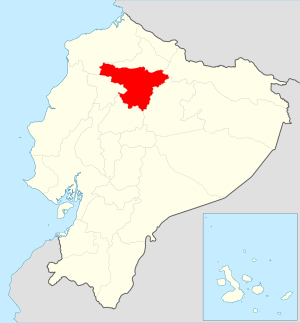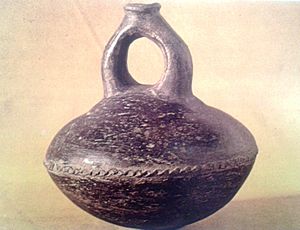Cotocollao culture facts for kids

Location of the Cotocollao culture
|
|
| Geographical range | Pichincha |
|---|---|
| Period | Formative |
| Dates | c. 1,500 – 500 BCE |
| Preceded by | Valdivia culture |
| Followed by | Quitu culture |
The Cotocollao culture was an ancient group of people who lived in the valley where the city of Quito, Ecuador, is today. They were one of the first groups to settle in the mountains of what is now Ecuador. They lived there a very long time ago, from about 1,500 to 500 years before the Common Era (BCE). This time is known as the Formative Period.
Life in the Cotocollao Villages
The Cotocollao people were mostly farmers. They grew important crops like corn, beans, quinoa, potatoes, and Lupin beans. They also hunted animals such as deer, rabbits, guanta, and guinea pigs. Sometimes, they hunted larger animals like pumas and wolves, and birds like doves.
They lived in small villages. Their homes were rectangular huts. These huts were built with wood and mud, and had roofs made of straw. The Cotocollao people also made their own clothes. They wove fabric from cotton to create their clothing.
Amazing Cotocollao Art
One of the most special things about the Cotocollao people was their skill in making ceramic artwork. Ceramics are objects made from clay and then hardened by heat. They created many beautiful ceramic pieces. These items were often more for decoration than for everyday use. We don't know if they had special workshops in their homes for making these artworks.
To make their ceramics, the Cotocollaos used a special clay mixture. It included powder from pumice, which is a light, porous volcanic rock. Their ceramics are famous for their unique red color. The Cotocollao artists were so good that some of their ceramic pieces could even make sounds! They could sound like animals or birds. The quality of their ceramics was better than any other art from that time.
Archaeologists have found thousands of ceramic pieces from the Cotocollao culture. About 20% of these pieces have decorations. These decorations include carved lines, red paint, and sometimes a shiny, rainbow-like coating.
Why the Cotocollao Left
Over time, the Cotocollao people slowly left their homes. This happened because of eruptions from the Pululahua volcano. The ash and changes in the land likely made it hard to live there.


